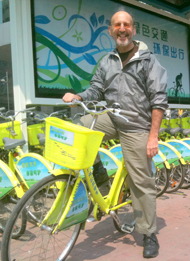I’ve written here before about the substantial part of the climate challenge that isn’t out in the world of greenhouse gases and coal furnaces, but within the human mind.
Still, I was intrigued earlier this month when I heard from Renee Lertzman, a research fellow in humanities and sustainability at Portland State University,
that she was speaking on “the myth of apathy,” the subject of a book she’s writing, at “Engaging With Climate Change: Psychoanalytic Perspectives,”
a meeting of psychoanalysts and behavioral researchers in London.
In regarding the polarized, confused, paralyzed discourse around global warming for more than two decades (including my own focus on the field for so long), I’ve sometimes
thought that Freud would have had a field day in this realm. Now his successors may be starting to dive in. (The photograph below is from the Freud Museum in London.)

Lertzman sent a link to the “Beyond the Couch” Web site of the Institute for Psychoanalysis, which held a
fascinating list of talks at the meeting, including “Unconscious obstacles to caring for the planet,” “Engaging with the natural world and with human nature” and “Climate
change denial in a perverse culture.”
I invited Lertzman to send a Dot Earth “post card,” which you can read below, followed by a brief set of followup questions and her replies:
I’ve just returned from speaking at the international headquarters of psychoanalysis, the Institute of Psychoanalysis, established in 1913 in London…. I imagine this was the first time eminent
psychoanalysts, environmental professionals, activists and scholars have gathered within these hallowed halls to contemplate our current environmental predicaments. For two full days, almost two hundred
people came together to “shrink” the climate change crisis….
Psychoanalysis may be most popularly known as an insular and esoteric relic of the Victorian era. However, it’s come a long way since Freud; this event ably demonstrated that psychoanalysis is an
essential voice on these matters. At least it is, if we want to address the messiness of how the human mind can cope with such overwhelming issues.
What are the unconscious dimensions of climate change? Is it possible that anxiety and fear are profoundly impeding our abilities to respond proactively and creatively to our impending crises? How can we
explain the inertia and paralysis on the part of both the public and our politicians? Read more…











